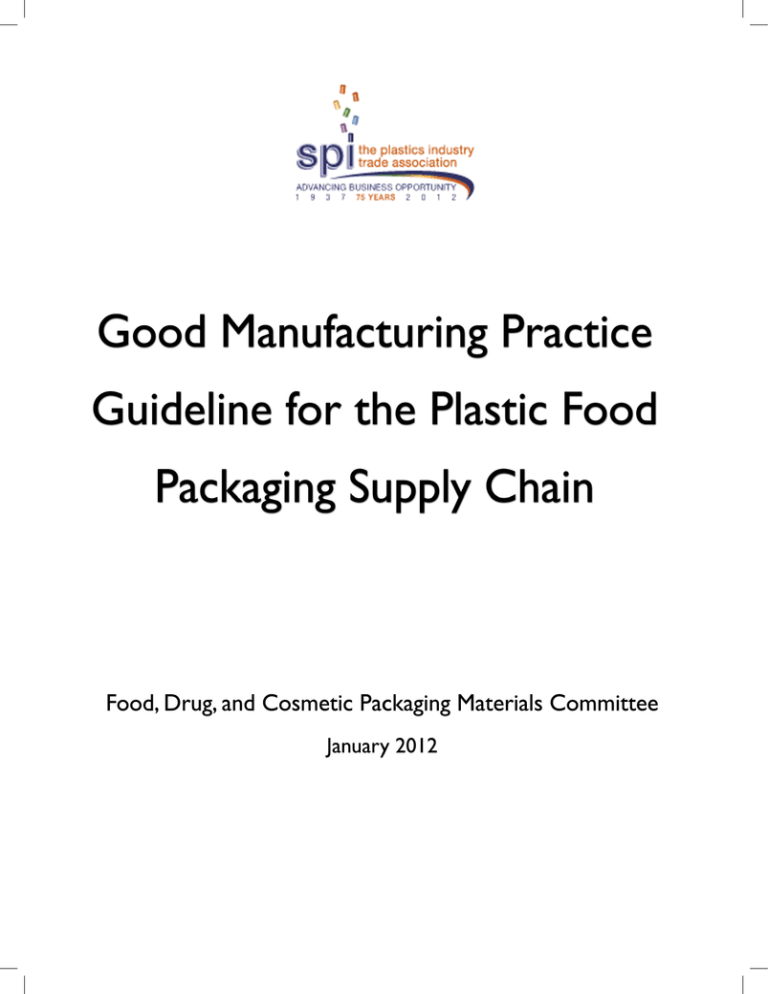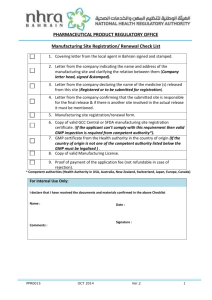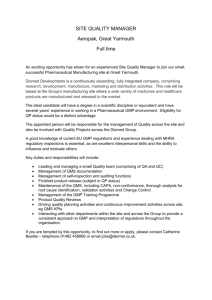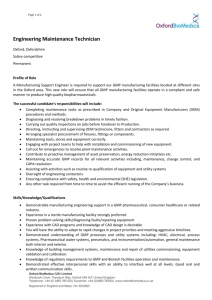
© 2012 The Society of the Plastics Industry, Inc. All rights reserved
1
COPYRIGHT AND DISCLAIMER
This report is copyright 2012, The Society of the
Plastics Industry, Inc. (SPI) Food, Drug, and Cosmetic
Packaging Materials Committee. All rights reserved.
This publication has been prepared by SPI as a service
to the industry. This document is intended for use as
a general reference tool, and is not intended to and
does not establish any industry standards or duty
of care. Any examples included in the publication
are not intended to be directed to any particular
product and should not be considered an appropriate
model without further considerations to a company’s
good manufacturing practice program.
This
publication is not intended to provide specific advice,
legal or otherwise, on the development of Good
Manufacturing Practices and procedures. Readers
should consult with their own legal and technical
advisors, their suppliers, and other appropriate
sources, which contain information about known
and reasonably foreseeable health and safety risks for
their proprietary products and processes. Readers
are solely responsible for and assume the risk arising
from the use of the information provided in this
publication. SPI, its members, contributors, agents,
© 2012 The Society of the Plastics Industry, Inc. All rights reserved
and attorneys make no warranty, express or implied,
as to the accuracy, completeness, or suitability of the
information provided herein, and do not assume
any responsibility for the user’s compliance with
applicable laws and regulations.
2
TABLE OF CONTENTS
COPYRIGHT AND DISCLAIMER
2
PREAMBLE
4
INTRODUCTION
4
CATEGORY 1 – GMP PLAN 5
CATEGORY 2 – MANAGEMENT LEADERSHIP AND PERSONAL
5
CATEGORY 3 – HYGIENE AND PEST CONTROL
5
CATEGORY 4 – DOCUMENTATION
5
CATEGORY 5 – FLOW OF OPERATIONS
6
CATEGORY 6 – DEFENSE AND PRODUCT SECURITY
7
CATEGORY 7 – TRACEABILITY
7
CATEGORY 8 – INCIDENT AND NON-CONFORMANCE PROTOCOLS
7
CATEGORY 9 – INTERNAL AND SUPPLIER ASSESSMENTS
7
CATEGORY 10 – CONTRACTED WORK
7
CATEGORY 11 – MANAGEMENT OF CHANGE8
GLOSSARY
SELECTED SOURCES OF INFORMATION ON PLASTICS-RELATED GMP 9
10
© 2012 The Society of the Plastics Industry, Inc. All rights reserved
3
PREAMBLE
This SPI guideline for the plastics industry was
prepared by representatives of numerous SPI
member companies which, themselves, comprise
numerous links in the plastic food, drug, and
cosmetic packaging materials manufacturing supply
chain. The document is intended as a guide to assist
employees whose responsibilities include assurance
of their companies’ adherence to appropriate Good
Manufacturing Practices (GMP). It is intended to
serve as a general reference tool for companies and
facilities throughout the plastic packaging supply
chain, from resin manufacturer through packaging
converter. This document does not establish a
GMP program that would be appropriate for any
particular facility. Rather, this document serves as a
guide for topics and areas that should be considered
during development of a GMP program. Any GMP
program must be tailored to a specific facility, its
manufacturing conditions, the nature of the product
being manufactured, and the product’s intended use
in the packaging supply chain. It is hoped that the
concepts and principles discussed below will be a
useful tool to assist practitioners with developing an
appropriate GMP program for their own facility.
INTRODUCTION
The concept of good manufacturing practice (GMP)
underpins the manufacture of all products regulated
by the Food and Drug Administration (FDA).
Food and food packaging must be manufactured
under a GMP program that prevents contamination
and ensures products will be safe. The regulatory
requirements for a well-designed GMP program
vary by the type of product being produced and by
the position of the product in the manufacturing
process and supply chain. GMP must always be
considered with regard to the intended use of the
product itself, and it is important for all companies
that produce food packaging and other food contact
materials to understand the appropriate GMP
for their individual products. Manufacturers of
food products have different GMP requirements
than a company that manufactures, for example, a
plastic liner that is used to hold the food product.
© 2012 The Society of the Plastics Industry, Inc. All rights reserved
Likewise, a manufacturer of an additive or resin that
is used in the plastic liner will be subject to different
GMP than a company converting those materials
into a finished plastic liner.
With regard to regulatory requirements, FDA’s GMP
standards for food contact materials are set forth
in Section 174.5 of the food additive regulations
(21 C.F.R. § 174.5). Section 174.5 simply states the
requirement that the regulations for food contact
materials are predicated by the requirements of
good manufacturing practice. In comparison to the
GMP standards for direct food additives (described
in 21 C.F.R. Part 110), FDA’s GMP regulations for
food packaging provide very little specific guidance.
The GMP requirements for direct food additives and
finished food are not required or appropriate for
food contact materials, and FDA has not prescribed
the details of appropriate GMP for packaging and
other components of food contact materials.
From a practical standpoint, GMPs for indirect food
additives (including packaging) require the use of
sensible measures to assure the products are made
under conditions that minimize the possibilities of
contamination that could result in the adulteration
of food, and sufficient documentation of these
conditions. Such measures also must ensure that
the food contact product is of a purity suitable for
its intended use; material that is not of suitable
purity is unacceptable for use in contact with food,
even if the material otherwise complies with the
compositional requirements of an applicable food
additive regulation. These necessary measures vary
depending on the nature of the product and how
close it is to the finished product, i.e., whether it
is a component of some other product, is subject
to further processing and perhaps purification, or
is a finished packaging material. For example, a
manufacturer of calcium carbonate used as a filler
in a polymer may focus more on ensuring the purity
of the substance and storing it under appropriate
conditions, while a polyethylene terephthalate resin
producer may place more emphasis on compliance
with the applicable specifications described in the
regulations and controlling the levels of residual
monomers.
4
Any manufacturer of a product that may become a
component of food has a general obligation to take
all reasonable steps necessary to minimize potential
impurities and contaminants in the product, and
to institute procedures to ensure that the finished
product conforms to appropriate specifications.
Heroic measures are not required; instead,
reasonable care must be taken to assure GMP
compliance. This includes considering existing
regulatory requirements and industry standards.
This guidance does not supplant these sources of
GMP requirements, but rather provides general
principles to assist with implementation. Factors
such as technological limitations, the toxicity of
the components at issue, and others may also affect
development of the GMP program and must be
considered on an individual basis.
CATEGORY 3 - HYGIENE AND PEST
CONTROL
CATEGORY 1 - GMP PLAN
CATEGORY 4 – DOCUMENTATION
Many of the essential principles of an appropriate
GMP program are incorporated into effective,
accountable, documented management systems
under any title including, but not limited to, “GMP.”
The design of a “GMP” program can build upon
existing quality systems, which may be deemed to be
sufficient in and of themselves.
CATEGORY 2 - MANAGEMENT
LEADERSHIP AND PERSONNEL
Management should provide appropriate resources
for qualified supervisory and involved personnel to
perform GMP activities related to finished articles,
intermediate materials and food contact substances.
• Management responsibilities for GMP
implementation should be assigned, defined
and documented.
• Personnel should be adequately trained in a
manner that they can understand, observe, and
implement the requirements of a company’s
GMP plan.
© 2012 The Society of the Plastics Industry, Inc. All rights reserved
• Hygiene measures, as appropriate to the
process and/or position in the supply
chain, should be implemented, maintained,
and documented for personnel, factories,
warehouses, and transportation vehicles/
vessels/containers.
• Pest control measures should be maintained
and documented as appropriate to the
manufacturing process and/or position in
the supply chain. Care should be taken
that the pest control measures employed
are appropriate for use in proximity to food
contact materials (include consideration of
organoleptic properties).
• GMP documents referenced in other sections
of this GMP Guideline should be retained
and periodically reviewed and updated per
individual company policy.
• Examples may include:
• specifications
• declarations and assurances
• product formulations
• batch/lot records
• process parameters
• control procedures
• test methods and analytical records
• calibration
• standard operating procedures
• management of change
• maintenance/cleaning protocols
• non-conformance investigations
5
CATEGORY 5 - FLOW OF OPERATIONS
Raw Material Specifications and Acceptance
Criteria
• Specifications should be established, reviewed
and re-validated on a regular basis, as deemed
appropriate.
• Companies should consider a process to
specify and approve raw materials based on
their conformity with applicable regulations
and rules of suitable purity for their intended
use.
• A process should be determined for approving
suppliers of raw materials.
• A process should be considered to verify raw
materials’ conformance, and to identify and
control non-conformant materials.
• Resulting documentation - including, for
example, supplier declarations and assurances –
should be maintained and reviewed as deemed
appropriate.
Process and Product Specifications and
Evaluation
• Specifications should be established, reviewed
and re-validated on a regular basis, as deemed
appropriate.
• Procedures to verify manufacturing process
conformance with applicable specifications,
and to identify and control non-conformant
process parameters should be documented.
These procedures should address internally
generated and recycled materials, as
appropriate.
• Procedures should be documented to verify
product conformance with applicable
specifications, and to identify and control nonconformant products.
Facilities and Equipment
Consideration should be given to the processes
used to design, install and maintain facilities and
equipment for purposes of protecting product
integrity and purity. Some examples may include
© 2012 The Society of the Plastics Industry, Inc. All rights reserved
but are not limited to:
•
•
•
•
Water of suitable quality;
Ice, water backflow prevention;
Waste water management;
Ancillary materials (e.g., machine lubricants,
process lubricants, other processing aids).
The following examples may apply to open processes
and not to closed processes:
• Lighting (e.g., shatterproof or guarded/
shielded)
• Facilities’ condition (e.g., holes in walls, roofs,
exterior grounds,)
• Employee facilities (e.g., personal storage
lockers, cafeteria/break room, restrooms, hand
washing facilities)
Laboratories
Internal and external laboratories should possess the
qualifications and capabilities deemed necessary to
provide accurate and reliable results.
Contamination Prevention
Processes should be in place to identify, assess, and
control critical hazards, if any, that might otherwise
result in contamination of products by unwanted
biological, chemical, and/or physical agents.
Considerations include:
• Equipment and set up procedures to control
cross-contamination.
• Procedures to control cross-contamination
when transitioning from one product to
another.
• Control systems to prevent crosscontamination among raw materials, work in
process, auxiliary materials, maintenance and
cleaning supplies, finished products, etc., as
appropriate.
• Procedures to control contamination during
materials handling, transfer, packaging and
loading operations.
6
Packaging and Labeling
• Processes should be considered to specify
and approve product packaging materials
in accordance with applicable industry and
authoritative standards.
• Companies should adopt procedures to ensure
all materials are properly and clearly identified
and labeled, as appropriate, with respect to
such examples as ancillary materials, finished
products, work in process, and use chemicals.
• Containers should be properly closed and
adequately secured to prevent contamination.
Storage, Warehousing and Transportation
• Equipment used for storage and transportation
of materials should be designed to facilitate
sanitation and pest control operations.
• Storage facilities and transportation services
should protect the quality of materials (e.g.,
environmental controls, cross contamination,
and off-odors prevention).
• Procedures should be put into place to
minimize, identify, and mitigate damage and
contamination to containers and their contents.
• Inventory rotation practices should be designed
as appropriate (e.g., obsolescence, first in first
out).
CATEGORY 6 - DEFENSE AND PRODUCT
SECURITY
Security measures should be adequate to defend
against adulteration.
Preventive practices, as appropriate, may include the
following examples:
• Operations evaluated; vulnerabilities to
tampering and sabotage identified and
mitigated
• Access to facilities limited only to authorized
personnel; door keys issued and controlled;
employee and visitor I.D. badges
• Access from facilities’ exterior controlled. (e.g.:
locked doors, perimeter fencing, restricted
vehicle access, security personnel)
© 2012 The Society of the Plastics Industry, Inc. All rights reserved
• Secured incoming and outgoing transport
vehicles’ contents
• Effective information security controls
CATEGORY 7 – TRACEABILITY
• Traceability should be established throughout
the manufacturing process to facilitate
necessary actions. A product lot coding scheme
is one example of a traceability-facilitating
practice.
• This process should be tested to assess its
accuracy and reliability.
CATEGORY 8 - INCIDENT AND NONCONFORMANCE PROTOCOLS
• A system should be established for recording
and investigating incidents and nonconformances and initiating appropriate
responses, which may include product recovery
if needed.
• Appropriate reactive, corrective and preventive
actions should result from this process.
• This process should be tested to assess its
effectiveness. The test may include, for
example, mock product recovery exercises.
CATEGORY 9 INTERNAL AND
SUPPLIER ASSESSMENTS
GMP elements should be subjected to assessments
to gauge effectiveness. An audit is one type of
assessment.
CATEGORY 10 - CONTRACTED WORK
Providers of contracted services (e.g., toll
manufacturing facilities, storage facilities,
sanitation services, transportation services, onsite contractors) should be required to adhere to
applicable elements included in this GMP guideline.
7
CATEGORY 11 - MANAGEMENT OF
CHANGE
Procedures should be considered to guide
employees in the initiation, review, approval
and proper communication (internally and/or
externally) of changes that impact GMP included in
this guideline.
© 2012 The Society of the Plastics Industry, Inc. All rights reserved
8
GLOSSARY
These definitions do not supersede or replace legal or regulatory definitions. Rather, these definitions
reflect the conventional understanding of practitioners to whom this document is addressed. Practitioners
should reference regulatory and guidance documents applicable to their operations while considering their
customers’ specifications.
Good Manufacturing Practice (GMP): those activities and procedures which reasonably assure finished
articles, intermediate materials, or food contact substances are produced and controlled to conform with
applicable regulations and standards of suitable purity for their intended use.
Food: that which is intended for consumption by humans, domesticated pets, and/or livestock.
Finished Article: the finished film, bottle, tray, etc., formed from food contact substances and/or
intermediate materials, in which food is packaged and/or held.
Intermediate Material: comprised of one or more food contact substances, intermediate material is used
to form the finished article. It is not an intermediate process step prior to the formation of a food contact
substance.
Food Contact Substance (FCS): One authoritative definition is in Section 409 of the U.S. Federal Food, Drug
& Cosmetic Act, which defines an FCS as any substance that is intended for use as a component of materials
used in manufacturing, packing, packaging, transporting, or holding food if such use of the substance is not
intended to have any technical effect in such food.
Closed Process: a manufacturing process that is self-contained and not exposed to the ambient environment.
Open Process: a manufacturing process that has one or more vessels, feeders, or transfer systems that are not
self-contained and therefore exposed to the site’s ambient environment.
Contamination: the presence of unintended biological, chemical, or physical agents in finished articles,
intermediate materials, or food contact substances.
Policy: an overall plan articulating general goals and acceptable procedures.
Raw Materials: intentionally added chemicals or mixtures that take part in or are present during the
production of food contact substances, intermediate materials, and finished articles.
Suitable purity: a determination that byproducts or impurities are not present at levels that would cause an
adverse health, safety and/or organoleptic effect when the finished article is used, as intended, in contact with
food. Articles intended for use in contact with food must be compositionally compliant with the applicable
food additive regulations and of a purity suitable for their intended use.
Traceability: the ability to trace the history, application, or location of a food contact substance, intermediate
material or finished article of interest through production, processing, and distribution, from the supplier
(one step back) to the intended customer (one step forward).
© 2012 The Society of the Plastics Industry, Inc. All rights reserved
9
Selected Sources of Information on Plastics-Related Good Manufacturing Practice
Consolidated Standards for Inspection: Food Contact Packaging Manufacturing Facilities
AIB International (2010)
http://www.aibonline.org/Standards/Food_Contact_Pk_Eng_Man_Web.pdf
Global Standard for Packaging and Packaging Materials
British Retail Consortium (2011)
http://www.brcglobalstandards.com/standards/packaging-and-packaging-materials/
PAS 223: Prerequisite programmes and design requirements for food safety in the manufacture and provision
of food packaging
British Standards Institute (2011)
http://shop.bsigroup.com/en/SearchResults/?q=PAS223
Commission Regulation (EC) 2023/2006 of 22 December 2006 on good manufacturing practice for materials
and articles intended to come into contact with food, Official Journal of the European Union, L384, 29-122006, pp. 75-78.
http://eur-lex.europa.eu/LexUriServ/LexUriServ.do?uri=OJ:L:2006:384:0075:0078:EN:PDF
Food and Cosmetic Security Preventative Measures Guidance
Department of Health and Human Services, Food and Drug Administration (2007)
http://www.fda.gov/Food/FoodDefense/FoodSecurity/default.htm
Grade “A” Pasteurized Milk Ordinance, Appendix J (2009 Revision)
Department of Health and Human Services; Public Health Service;
Food and Drug Administration
http://www.fda.gov/food/foodsafety/Product-SpecificInformation/MilkSafety/default.htm
Code for Good Manufacturing Practices for the European Aluminum Industry
European Aluminium Association (2008)
http://www.alueurope.eu/wp-content/uploads/2011/08/EAA-GMP-Aug081.pdf
Good Manufacturing Practices for the Production of Packaging Inks formulated for use on the non-foodcontact surfaces of food packaging and articles intended to come into contact with food
European Printing Ink Association (2009)
http://www.eupia.org/EPUB/easnet.dll/ExecReq/Page?eas:template_im=10008E&eas:dat_im=05048E
Code for Good Manufacturing Practices for Flexible and Fibre-Based Packaging for Food
Flexible Packaging Europe, CITPA (2011)
http://www.flexpack-europe.org/upload/Documents/FPE_GMP_Code_6.0.pdf
FSSC (Food Safety System Certification) 22000: Certification scheme for food safety systems in compliance
with ISO 22000: 2005 and BSI - PAS 220: 2008, Part I: Requirements for Organizations that Require
Certification
Foundation for Food Safety Certification (July 2010)
http://www.fssc22000.com/downloads/part1.pdf
© 2012 The Society of the Plastics Industry, Inc. All rights reserved
10
Product Safety, Quality and Defense Expectations and Criteria for Manufacturing Facilities of Food Contact
Packaging Materials, Food - Related Items, and Personal Care (Contact) Products
NSF Cook & Thurber (2011)
http://www.nsf.org/business/NSF_cook_and_thurber/documents.asp?program=NSFCooThu
Guidelines for Good Manufacturing Practice for Plastic Materials and Articles Intended for Food Contact
Applications
Plastics Europe, CEFIC-FCA, and European Plastics Converters
(December 2005, Updated April 2008)
http://www.plasticseurope.org/Document/guidelines-for-good-manufacturing-practice-for-plasticmaterials-and-articles-intended-for-food-contact-applications.aspx?Page=DOCUMENT&fOLid=2
Guidance for Developing, Documenting and Implementing an SQF 2000 System – General Food Packaging
Materials - Manufacture and Distribution
Safe Quality Food Institute (2010)
http://www.sqfi.com/wp-content/uploads/2000-Guidance-FoodPack.pdf
© 2012 The Society of the Plastics Industry, Inc. All rights reserved
11
© 2012 The Society of the Plastics Industry, Inc. All rights reserved
12




